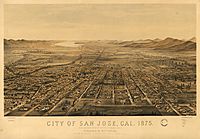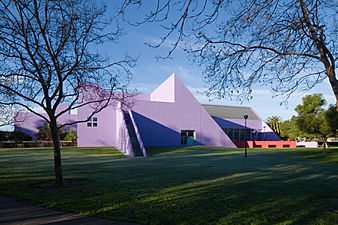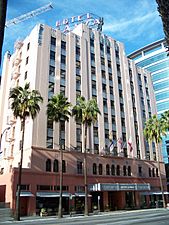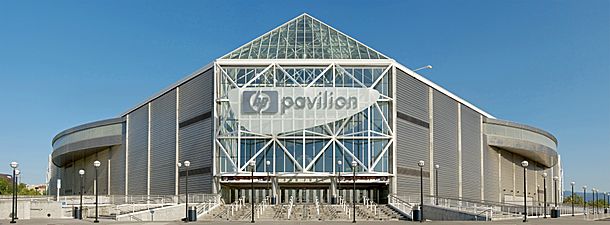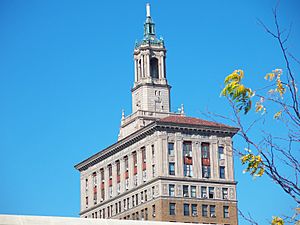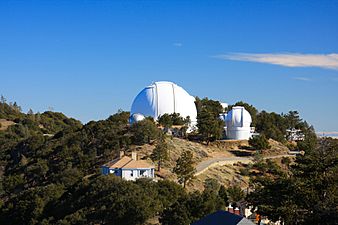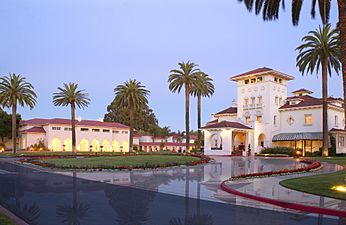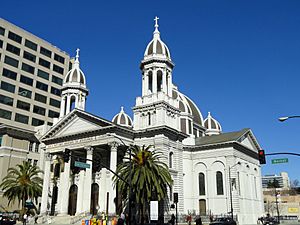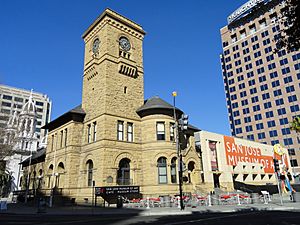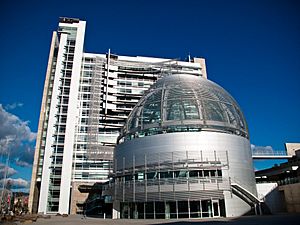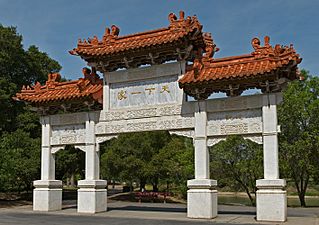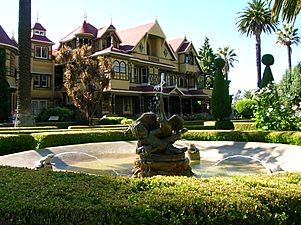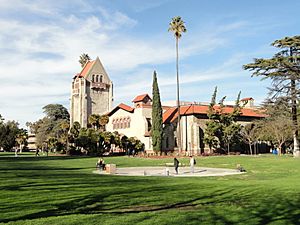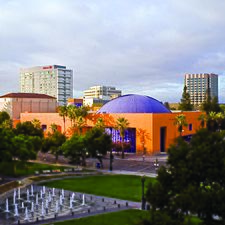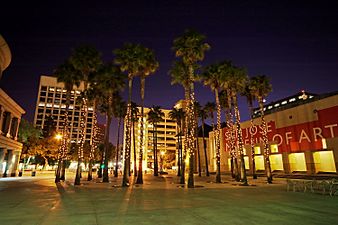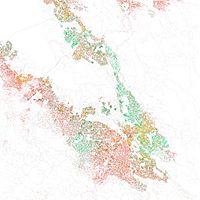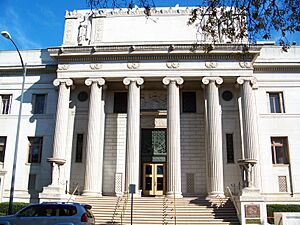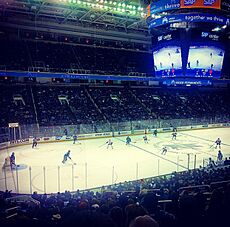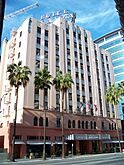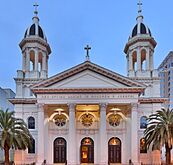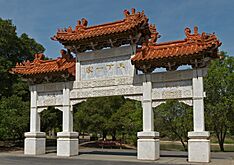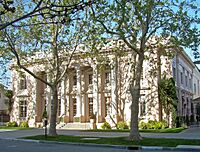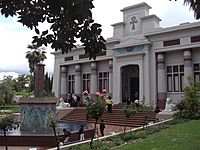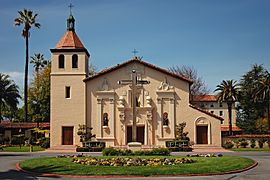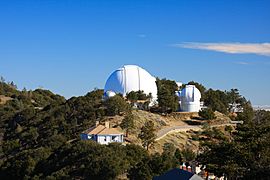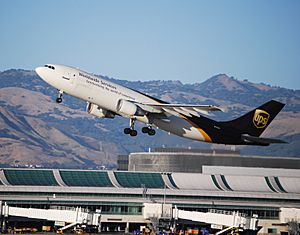San Jose, California facts for kids
Quick facts for kids
San Jose
|
|||||
|---|---|---|---|---|---|
| City of San José | |||||
|
Downtown skyline
|
|||||
|
|||||
| Motto(s):
Capital of Silicon Valley
|
|||||
| Country | United States | ||||
| State | California | ||||
| County | Santa Clara | ||||
| Region | San Francisco Bay Area | ||||
| Metro | San Jose-Sunnyvale-Santa Clara | ||||
| CSA | San Jose-San Francisco-Oakland | ||||
| Pueblo founded | November 29, 1777 | ||||
| Founded as | Pueblo de San José de Guadalupe | ||||
| Incorporated | March 27, 1850 | ||||
| Named for | Saint Joseph | ||||
| Government | |||||
| • Type | Council–manager | ||||
| • Body | San Jose City Council | ||||
| Area | |||||
| • City | 181.36 sq mi (469.72 km2) | ||||
| • Land | 178.24 sq mi (461.63 km2) | ||||
| • Water | 3.12 sq mi (8.09 km2) 1.91% | ||||
| • Urban | 285.48 sq mi (739.4 km2) | ||||
| • Metro | 2,694.61 sq mi (6,979 km2) | ||||
| Elevation | 82 ft (25 m) | ||||
| Lowest elevation | 0 ft (0 m) | ||||
| Population
(2020)
|
|||||
| • City | 1,013,240 | ||||
| • Estimate
(2022)
|
971,233 | ||||
| • Rank | 32nd in North America 13th in the United States 3rd in California |
||||
| • Density | 5,684.69/sq mi (2,194.92/km2) | ||||
| • Urban | 1,837,446 (US: 28th) | ||||
| • Urban density | 6,436.4/sq mi (2,485.1/km2) | ||||
| • Metro | 2,000,468 (US: 35th) | ||||
| Demonym(s) | San Josean(s) San Joséan(s) Josefino/a(s) |
||||
| Time zone | UTC−08:00 (PST) | ||||
| • Summer (DST) | UTC−07:00 (PDT) | ||||
| ZIP Codes |
List
95002
95008 95101 95103 95106 95108–95113 95115–95141 95148 95150–95161 95164, 95170 95172 95173 95129 95190–95194 95196 |
||||
| Area code(s) | 408/669 | ||||
| FIPS code | 06-68000 | ||||
| GNIS feature IDs | 1654952, 2411790 | ||||
San Jose, officially the City of San José (Spanish for 'Saint Joseph' /ˌsæn hoʊˈzeɪ, -ˈseɪ/ san-_-hoh-ZAY-,_---say; Spanish: [saŋ xoˈse]), is the largest city in Northern California by both population and area. With a 2022 population of 971,233, it is the most populous city in both the Bay Area and the San Jose–San Francisco–Oakland Combined Statistical Area—which in 2022 had a population of 7.5 million and 9.0 million respectively—the third-most populous city in California after Los Angeles and San Diego, and the 13th-most populous in the United States. Located in the center of the Santa Clara Valley on the southern shore of San Francisco Bay, San Jose covers an area of 179.97 sq mi (466.1 km2). San Jose is the county seat of Santa Clara County and the main component of the San Jose–Sunnyvale–Santa Clara Metropolitan Statistical Area, with an estimated population of around two million residents in 2018.
San Jose is notable for its innovation, cultural diversity, affluence, and sunny and mild Mediterranean climate. Its connection to the booming high tech industry phenomenon known as Silicon Valley prompted Mayor Tom McEnery to adopt the city motto of "Capital of Silicon Valley" in 1988 to promote the city. Major global tech companies including Cisco Systems, eBay, Adobe Inc., PayPal, Broadcom, and Zoom maintain their headquarters in San Jose. One of the wealthiest major cities in the world, San Jose has the third-highest GDP per capita (after Zurich and Oslo) and the fifth-most expensive housing market. It is home to one of the world's largest overseas Vietnamese populations, a Hispanic community that makes up over 40% of the city's residents, and historic ethnic enclaves such as Japantown and Little Portugal.
Before the arrival of the Spanish, the area around San Jose was long inhabited by the Tamien nation of the Ohlone peoples of California. San Jose was founded on November 29, 1777, as the Pueblo de San José de Guadalupe, the first city founded in the Californias. It became a part of Mexico in 1821 after the Mexican War of Independence.
Following the American Conquest of California during the Mexican–American War, the territory was ceded to the United States in 1848. After California achieved statehood two years later, San Jose was designated as the state's first capital. Following World War II, San Jose experienced an economic boom, with a rapid population growth and aggressive annexation of nearby cities and communities carried out in the 1950s and 1960s. The rapid growth of the high-technology and electronics industries further accelerated the transition from an agricultural center to an urbanized metropolitan area. Results of the 1990 U.S. census indicated that San Jose had officially surpassed San Francisco as the most populous city in Northern California. By the 1990s, San Jose had become the global center for the high tech and internet industries and was California's fastest-growing economy for 2015–2016. Between April 2020 and July 2022, San Jose lost 42,000 people, 4.1% of its population, dropping to 12th, and then 13th largest city position in largest city ranking.
Contents
Name
San Jose is named after el Pueblo de San José de Guadalupe (Spanish for 'the Town of Saint Joseph of Guadalupe'), the city's predecessor, which was eventually located in the area of what is now the Plaza de César Chávez. In the 19th century, print publications used the spelling "San José" for both the city and its eponymous township. On December 11, 1943, the United States Board on Geographic Names ruled that the city's name should be spelled "San Jose" based on local usage and the formal incorporated name.
In the 1960s and 1970s, some residents and officials advocated for returning to the original spelling of "San José", with the acute accent on the "e", to acknowledge the city's Mexican origin and Mexican-American population. On June 2, 1969, the city adopted a flag designed by historian Clyde Arbuckle that prominently featured the inscription "SAN JOSÉ, CALIFORNIA". On June 16, 1970, San Jose State College officially adopted "San José" as the city's name, including in the college's own name. On August 20, 1974, the San Jose City Council approved a proposal by Catherine Linquist to rename the city "San José" but reversed itself a week later under pressure from residents concerned with the cost of changing typewriters, documents, and signs. On April 3, 1979, the city council once again adopted "San José" as the spelling of the city name on the city seal, official stationery, office titles and department names. As late as 2010, the 1965 city charter stated the name of the municipal corporation as City of San Jose, without the accent mark, but later editions have added the accent mark.
By convention, the spelling San José is only used when the name is spelled in mixed upper- and lowercase letters, but not when the name is spelled only in uppercase letters, as on the city logo. The accent reflects the Spanish version of the name, and the dropping of accents in all-capital writing was once typical in Spanish. While San José is commonly spelled both with and without the acute accent over the "e", the city's official guidelines indicate that it should be spelled with the accent most of the time and sets forth narrow exceptions, such as when the spelling is in URLs, when the name appears in all-capital letters, when the name is used on social media sites where the diacritical mark does not render properly, and where San Jose is part of the proper name of another organization or business, such as San Jose Chamber of Commerce, that has chosen not to use the accent-marked name.
History
![]() Spanish Empire 1777–1821
Spanish Empire 1777–1821
![]() First Mexican Empire 1821–1823
First Mexican Empire 1821–1823
![]() United Mexican States 1823–1848
United Mexican States 1823–1848
![]() California Republic 1846
California Republic 1846
![]() United States 1848–present
United States 1848–present
Early history
Prior to European settlement, the area was inhabited by several groups of Ohlone Native Americans.
The first lasting European presence began with a series of Franciscan missions established from 1769 by Junípero Serra.
On orders from Antonio María de Bucareli y Ursúa, Spanish Viceroy of New Spain, San Jose was founded by Lieutenant José Joaquín Moraga as Pueblo de San José de Guadalupe (in honor of Saint Joseph) on November 29, 1777, to establish a farming community. The town was the first civil settlement in Alta California
In 1797, the pueblo was moved from its original location, near the present-day intersection of Guadalupe Parkway and Taylor Street, to a location in what is now Downtown San Jose. San Jose came under Mexican rule in 1821 after Mexico broke with the Spanish crown. It then became part of the United States, after it capitulated in 1846 and California was annexed.
Modern history
On March 27, 1850, San Jose became the second incorporated city in the state (after Sacramento), with Josiah Belden its first mayor. San Jose was California's first state capital, and hosted the first and second sessions (1850–1851) of the California Legislature. Today the Circle of Palms Plaza in downtown is the historical marker for the first state capital. The city was a station on the Butterfield Overland Mail route.
In the period 1900 through 1910, San Jose served as a center for pioneering invention, innovation, and impact in both lighter-than-air and heavier-than-air flight. These activities were led principally by John Montgomery and his peers. The City of San Jose has established Montgomery Park, a Monument at San Felipe and Yerba Buena Roads, and John J. Montgomery Elementary School in his honor. During this period, San Jose also became a center of innovation for the mechanization/industrialization of agricultural and food processing equipment.
Though not affected as severely as San Francisco, San Jose also suffered significant damage from the 1906 San Francisco earthquake. Over 100 people died at the Agnews Asylum (later Agnews State Hospital) after its walls and roof collapsed, and San Jose High School's three-story stone-and-brick building was also destroyed. The period during World War II was a tumultuous time. Japanese Americans primarily from Japantown were sent to internment camps, including the future mayor Norman Mineta. Following the Los Angeles zoot suit riots, anti-Mexican violence took place during the summer of 1943. In 1940, the Census Bureau reported San Jose's population as 98% white.
As World War II started, the city's economy shifted from agriculture (the Del Monte cannery was the largest employer) to industrial manufacturing with the contracting of the Food Machinery Corporation (later known as FMC Corporation) by the United States War Department to build 1,000 Landing Vehicle Tracked. After World War II, FMC (later United Defense, and currently BAE Systems) continued as a defense contractor, with the San Jose facilities designing and manufacturing military platforms such as the M113 Armored Personnel Carrier, the Bradley Fighting Vehicle, and various subsystems of the M1 Abrams battle tank.
IBM established its West Coast headquarters in San Jose in 1943 and opened a downtown research and development facility in 1952. Both would prove to be harbingers for the economy of San Jose, as Reynold Johnson and his team would later invent RAMAC, as well as the hard disk drive, and the technological side of San Jose's economy grew.
The Ford Motor Company relocated its factory in Richmond to a new location in the suburb of Milpitas, called the San Jose Assembly Plant, which was one of the primary locations for manufacturing the Ford Mustang.
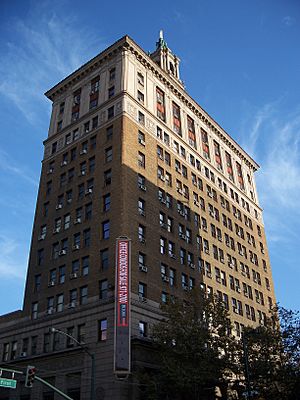
During the 1950s and 1960s, City Manager A. P. "Dutch" Hamann led the city in a major growth campaign. The city annexed adjacent areas, such as Alviso and Cambrian Park, providing large areas for suburbs. An anti-growth reaction to the effects of rapid development emerged in the 1970s, championed by mayors Norman Mineta and Janet Gray Hayes. Despite establishing an urban growth boundary, development fees, and the incorporations of Campbell and Cupertino, development was not slowed, but rather directed into already-incorporated areas.
On April 3, 1979, the San Jose City Council adopted San José, with the diacritical mark on the "e", as the spelling of the city name on the city seal, official stationery, office titles and department names. Also, by city council convention, this spelling of San José is used when the name is stated in mixed upper- and lower-case letters, but not when the name is stated only in upper-case letters. The accent reflects the Spanish version of the name, and the dropping of accents in all-capital writing was typical in Spanish. While San José is commonly spelled both with and without the acute accent over the "e," the city's official guidelines indicate that it should be spelled with the accent most of the time and sets forth narrow exceptions, such as when the spelling is in URLs, when the name appears in all-capital letters, when the name is used on social media sites where the diacritical mark does not render properly, and where San Jose is part of the proper name of another organization or business, such as San Jose Silicon Valley Chamber of Commerce, that has chosen not to use the accent-marked name. The city's name without the accent can still be found in its 1965 Charter document, as amended, which formally chartered the municipality as City of San Jose. Similarly, the city's website appears to use a mixture of both; for example, the "City of San José" in the text uses the mark but the "City of San Jose" logo image does not.
San Jose's position in Silicon Valley triggered further economic and population growth. Results from the 1990 U.S. Census indicated that San Jose surpassed San Francisco as the most populous city in the Bay Area for the first time. This growth led to the highest housing-cost increase in the nation, 936% between 1976 and 2001. Efforts to increase density continued into the 1990s when an update of the 1974 urban plan kept the urban growth boundaries intact and voters rejected a ballot measure to ease development restrictions in the foothills. Sixty percent of the housing built in San Jose since 1980 and over three-quarters of the housing built since 2000 have been multifamily structures, reflecting a political propensity toward Smart Growth planning principles.
Geography
San Jose is located at 37°20′07″N 121°53′31″W / 37.335278°N 121.891944°W. According to the United States Census Bureau, the city has a total area of 180.0 sq mi (466 km2), of which 3.4 sq mi (8.8 km2) (1.91%) is water.
San Jose lies between the San Andreas Fault, the source of the 1989 Loma Prieta earthquake, and the Calaveras Fault. San Jose is shaken by moderate earthquakes on average one or two times a year. These quakes originate just east of the city on the creeping section of the Calaveras Fault, which is a major source of earthquake activity in Northern California. On April 14, 1984, at 1:15 pm local time, a 6.2 magnitude earthquake struck the Calaveras Fault near San Jose's Mount Hamilton. The most serious earthquake, in 1906, damaged many buildings in San Jose as described earlier. Earlier significant quakes rocked the city in 1839, 1851, 1858, 1864, 1865, 1868, and 1891. The Daly City Earthquake of 1957 caused some damage. The Loma Prieta earthquake of 1989 also did some damage to parts of the city. The other faults near San Jose are the Monte Vista Fault and the Hayward Fault Zone.
Cityscape
The city is generally divided into the following areas: Downtown San Jose, Central, West San Jose, North San Jose, East San Jose, and South San Jose. Many of these regions were originally unincorporated communities or separate municipalities that were later annexed by the city.
Besides those mentioned above, some well-known communities within San Jose include Japantown, Rose Garden, Sunol-Midtown, Willow Glen, Naglee Park, Burbank, Winchester, Alviso, East Foothills, Alum Rock, Little Portugal, Blossom Valley, Cambrian, Almaden Valley, Silver Creek Valley, Evergreen Valley, Edenvale, Santa Teresa, Seven Trees, Coyote Valley, and Berryessa.
Sprawl
San Jose's urban sprawl was made by the design of "Dutch" Hamann, the City Manager from 1950 to 1969. During his administration, with his staff referred to as "Dutch's Panzer Division," the city annexed property 1,389 times, growing the city from 17 to 149 square miles (44 to 386 km2), absorbing the communities named above, changing their status to "neighborhoods."
Sales taxes were a chief source of revenue. Hamann would determine where major shopping areas would be, and then annex narrow bands of land along major roadways leading to those locations, pushing tentacles across the Santa Clara Valley and, in turn, walling off the expansion of adjacent communities.
During his reign, it was said the City Council would vote according to Hamann's nod. In 1963, the State of California imposed Local Agency Formation Commissions statewide, but largely to try to maintain order with San Jose's aggressive growth. Eventually the political forces against growth grew as local neighborhoods bonded together to elect their own candidates, ending Hamann's influence and leading to his resignation. While the job was not complete, the trend was set. The city had defined its sphere of influence in all directions, sometimes chaotically leaving unincorporated pockets to be swallowed up by the behemoth, sometimes even at the objection of the residents.
Landmarks
Important landmarks in San Jose include Children's Discovery Museum of San Jose, History Park at Kelley Park, Cathedral Basilica of St. Joseph, Plaza de César Chávez, Dr. Martin Luther King, Jr. Library, Mexican Heritage Plaza, Rosicrucian Egyptian Museum, Lick Observatory, Hayes Mansion, SAP Center at San Jose, Hotel De Anza, San Jose Improv, San Jose Municipal Stadium, Spartan Stadium, Japantown San Jose, Winchester Mystery House, Raging Waters, Circle of Palms Plaza, San Jose City Hall, San Jose Flea Market, Oak Hill Memorial Park, and The Tech Museum of Innovation.
Topography
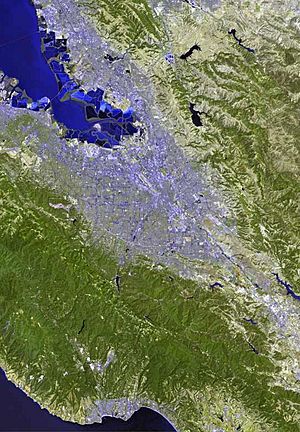
The Guadalupe River runs from the Santa Cruz Mountains (which separate the South Bay from the Pacific Coast) flowing north through San Jose, ending in the San Francisco Bay at Alviso. Along the southern part of the river is the neighborhood of Almaden Valley, originally named for the mercury mines which produced mercury needed for gold extraction from quartz during the California Gold Rush as well as mercury fulminate blasting caps and detonators for the U.S. military from 1870 to 1945. East of the Guadalupe River, Coyote Creek also flows to south San Francisco Bay and originates on Mount Sizer near Henry W. Coe State Park and the surrounding hills in the Diablo Range, northeast of Morgan Hill, California.
The lowest point in San Jose is 13 feet (4 m) below sea level at the San Francisco Bay in Alviso; the highest is 2,125 feet. Because of the proximity to Lick Observatory atop Mount Hamilton, San Jose has taken several steps to reduce light pollution, including replacing all street lamps and outdoor lighting in private developments with low pressure sodium lamps. To recognize the city's efforts, the asteroid 6216 San Jose was named after the city.
San Jose lies close to the Pacific Ocean and close to San Francisco Bay (a small portion of its northern border touches the bay). Santa Clara Valley is the population center of the Bay Area and, like the hub and spokes of a wheel, surrounding communities emanate outwards from the valley. This growth, in part, has shaped the greater Bay Area as it is today in terms of geographic population distribution and the trend of suburbanization away from the valley.
There are four distinct valleys in the city of San Jose: Almaden Valley, situated on the southwest fringe of the city; Evergreen Valley to the southeast, which is hilly all throughout its interior; Santa Clara Valley, which includes the flat, main urban expanse of the South Bay; and the rural Coyote Valley, to the city's extreme southern fringe.
Climate
San Jose, like most of the Bay Area, has a subtropical Mediterranean climate (Köppen Csb). San Jose has an average of 301 days of sunshine and an annual mean temperature of 60.5 °F (15.8 °C). It lies inland, surrounded on three sides by mountains, and does not front the Pacific Ocean like San Francisco. As a result, the city is somewhat more sheltered from rain, giving it a semiarid feel with a mean annual rainfall of 15.82 in (402 mm), compared to some other parts of the Bay Area, which can receive about three times that amount.
Like most of the Bay Area, San Jose is made up of dozens of microclimates. Because of a more prominent rain shadow from the Santa Cruz Mountains, Downtown San Jose experiences the lightest rainfall in the city, while South San Jose, only 10 mi (16 km) distant, experiences more rainfall, and somewhat more extreme temperatures.
The monthly daily average temperature ranges from around 50 °F (10 °C) in December and January to around 70 °F (21 °C) in July and August. The highest temperature ever recorded in San Jose was 114 °F (46 °C) on June 14, 1961; the lowest was 19 °F (−7 °C) on December 22–23, 1990. On average, there are 2.7 nights annually where the temperature lowers to or below the freezing mark, and 16 days where the high reaches or exceeds 90 °F (32 °C). Diurnal temperature variation is far wider than along the coast or in San Francisco but still a shadow of what is seen in the Central Valley.
| Climate data for San Jose, California (1981–2010 normals, extremes 1893–present) | |||||||||||||
|---|---|---|---|---|---|---|---|---|---|---|---|---|---|
| Month | Jan | Feb | Mar | Apr | May | Jun | Jul | Aug | Sep | Oct | Nov | Dec | Year |
| Record high °F (°C) | 79 (26) |
81 (27) |
89 (32) |
95 (35) |
102 (39) |
109 (43) |
108 (42) |
105 (41) |
106 (41) |
101 (38) |
85 (29) |
79 (26) |
109 (43) |
| Mean daily maximum °F (°C) | 58.1 (14.5) |
61.9 (16.6) |
65.7 (18.7) |
69.3 (20.7) |
74.3 (23.5) |
79.1 (26.2) |
81.9 (27.7) |
81.9 (27.7) |
80.1 (26.7) |
74.0 (23.3) |
64.3 (17.9) |
58.0 (14.4) |
70.7 (21.5) |
| Daily mean °F (°C) | 50.1 (10.1) |
53.3 (11.8) |
56.2 (13.4) |
58.9 (14.9) |
63.4 (17.4) |
67.5 (19.7) |
70.0 (21.1) |
70.1 (21.2) |
68.5 (20.3) |
63.2 (17.3) |
55.1 (12.8) |
50.0 (10.0) |
60.5 (15.8) |
| Mean daily minimum °F (°C) | 42.0 (5.6) |
44.7 (7.1) |
46.6 (8.1) |
48.6 (9.2) |
52.4 (11.3) |
56.0 (13.3) |
58.1 (14.5) |
58.3 (14.6) |
56.8 (13.8) |
52.5 (11.4) |
46.0 (7.8) |
41.9 (5.5) |
50.3 (10.2) |
| Record low °F (°C) | 18 (−8) |
24 (−4) |
25 (−4) |
26 (−3) |
32 (0) |
33 (1) |
40 (4) |
39 (4) |
35 (2) |
30 (−1) |
21 (−6) |
19 (−7) |
18 (−8) |
| Average rainfall inches (mm) | 3.07 (78) |
3.11 (79) |
2.54 (65) |
1.18 (30) |
0.51 (13) |
0.10 (2.5) |
0.02 (0.51) |
0.02 (0.51) |
0.18 (4.6) |
0.80 (20) |
1.68 (43) |
2.61 (66) |
15.82 (402.12) |
| Average rainy days (≥ 0.01 in) | 10.2 | 10.3 | 9.4 | 5.6 | 3.2 | 0.8 | 0.2 | 0.3 | 1.3 | 3.2 | 7.2 | 10.2 | 61.9 |
| Source: NOAA | |||||||||||||
With the light rainfall, San Jose and its suburbs experience about 300 fully or partly sunny days a year. Rain occurs primarily in the months from November through April or May. During the winter and spring, hillsides and fields turn green with grasses and vegetation, although deciduous trees are few. With the coming of the annual hot summer dry period, the vegetation dies and dries, giving the hills a golden cover which, unfortunately, also provides fuel for frequent grass fires.
Measurable precipitation falls in downtown San Jose on an average of 62 days a year. of rain, causing some flooding.
The snow level drops as low as 2,000 ft (610 m) above sea level, or lower, occasionally coating nearby Mount Hamilton and, less frequently, the Santa Cruz Mountains, with snow that normally lasts a few days. This sometimes snarls traffic traveling on State Route 17 towards Santa Cruz. Snow rarely falls in San Jose; the most recent snow to remain on the ground was on February 5, 1976, when many residents around the city saw as much as 3 in (7.6 cm) on car and roof tops. The official observation station measured only 0.5 in (1.3 cm) of snow.
Demographics
| Historical population | |||
|---|---|---|---|
| Census | Pop. | %± | |
| 1870 | 9,089 | — | |
| 1880 | 12,567 | 38.3% | |
| 1890 | 18,060 | 43.7% | |
| 1900 | 21,500 | 19.0% | |
| 1910 | 28,946 | 34.6% | |
| 1920 | 39,642 | 37.0% | |
| 1930 | 57,651 | 45.4% | |
| 1940 | 68,457 | 18.7% | |
| 1950 | 95,280 | 39.2% | |
| 1960 | 204,196 | 114.3% | |
| 1970 | 459,913 | 125.2% | |
| 1980 | 629,400 | 36.9% | |
| 1990 | 782,248 | 24.3% | |
| 2000 | 894,943 | 14.4% | |
| 2010 | 945,942 | 5.7% | |
| 2020 | 1,013,240 | 7.1% | |
| 2023 (est.) | 969,655 | 2.5% | |
| U.S. Decennial Census 2010–2020 |
|||
In 2022, the US Census Bureau released its new population estimates. With a total population of 971,233, San Jose showed a 4.1% decline in population since the 2020 census. Some reasons for this decline are people leaving the area for more affordable cities and more remote working opportunities.
| Historical racial composition | 2020 | 2010 | 1990 | 1970 | 1940 |
|---|---|---|---|---|---|
| Asian | 37.2% | 31.7% | 19.5% | 2.7% | 1.1% |
| Hispanic or Latino (of any race) | 31.0% | 33.2% | 26.6% | 19.1% | n/a |
| White (non-Hispanic) | 25.1% | 28.7% | 49.6% | 75.7% | 98.5% |
| Mixed | 7.9% | 2.7% | n/a | n/a | n/a |
| Black or African American | 2.9% | 2.9% | 4.7% | 2.5% | 0.4% |
2020
| Race / Ethnicity (NH = Non-Hispanic) | Pop 2000 | Pop 2010 | Pop 2020 | % 2000 | % 2010 | % 2020 |
|---|---|---|---|---|---|---|
| White alone (NH) | 322,534 | 271,382 | 236,095 | 36.04% | 28.69% | 23.30% |
| Black or African American alone (NH) | 29,495 | 27,508 | 27,422 | 3.30% | 2.91% | 2.71% |
| Native American or Alaska Native alone (NH) | 2,959 | 2,255 | 1,921 | 0.33% | 0.24% | 0.19% |
| Asian alone (NH) | 238,378 | 300,022 | 386,993 | 26.64% | 31.72% | 38.19% |
| Pacific Islander alone (NH) | 3,093 | 3,492 | 3,460 | 0.35% | 0.37% | 0.34% |
| Other race alone (NH) | 1,699 | 1,820 | 4,808 | 0.19% | 0.19% | 0.47% |
| Mixed race or Multiracial (NH) | 26,796 | 25,827 | 36,275 | 2.99% | 2.73% | 3.58% |
| Hispanic or Latino (any race) | 269,989 | 313,636 | 316,266 | 30.17% | 33.16% | 31.21% |
| Total | 894,943 | 945,942 | 1,013,240 | 100.00% | 100.00% | 100.00% |
2010
The 2010 United States Census reported that San Jose had a population of 945,942. The population density was 5,256.2 people per square mile (2,029.4/km2). The racial makeup of San Jose was 404,437 (42.8%) White, 303,138 (32.0%) Asian (10.4% Vietnamese, 6.7% Chinese, 5.6% Filipino, 4.6% Indian, 1.2% Korean, 1.2% Japanese, 0.3% Cambodian, 0.2% Thai, 0.2% Pakistani, 0.2% Laotian), 30,242 (3.2%) African American, 8,297 (0.9%) Native American, 4,017 (0.4%) Pacific Islander, 148,749 (15.7%) from other races, and 47,062 (5.0%) from two or more races. There were 313,636 residents of Hispanic or Latino background (33.2%). 28.2% of the city's population was of Mexican descent; the next largest Hispanic groups were those of Salvadoran (0.7%) and Puerto Rican (0.5%) heritage. Non-Hispanic Whites were 28.7% of the population in 2010, down from 75.7% in 1970.
The census reported that 932,620 people (98.6% of the population) lived in households, 9,542 (1.0%) lived in non-institutionalized group quarters, and 3,780 (0.4%) were institutionalized. There were 301,366 households, out of which 122,958 (40.8%) had children under the age of 18 living in them, 162,819 (54.0%) were opposite-sex married couples living together, 37,988 (12.6%) had a female householder with no husband present, 18,702 (6.2%) had a male householder with no wife present. There were 16,900 (5.6%) unmarried opposite-sex partnerships, and 2,458 (0.8%) same-sex married couples or partnerships. 59,385 households (19.7%) were made up of individuals, and 18,305 (6.1%) had someone living alone who was 65 years of age or older. The average household size was 3.09. There were 219,509 families (72.8% of all households); the average family size was 3.54.
The age distribution of the city was as follows: 234,678 people (24.8%) were under the age of 18, 89,457 people (9.5%) aged 18 to 24, 294,399 people (31.1%) aged 25 to 44, 232,166 people (24.5%) aged 45 to 64, and 95,242 people (10.1%) who were 65 years of age or older. The median age was 35.2 years. For every 100 females, there were 101.1 males. For every 100 females age 18 and over, there were 99.8 males.
There were 314,038 housing units at an average density of 1,745.0 per square mile (673.7/km2), of which 176,216 (58.5%) were owner-occupied, and 125,150 (41.5%) were occupied by renters. The homeowner vacancy rate was 1.6%; the rental vacancy rate was 4.3%. 553,436 people (58.5% of the population) lived in owner-occupied housing units and 379,184 people (40.1%) lived in rental housing units.
2000
As of the census of 2000, there were 894,943 people, 276,598 households, and 203,576 families residing in the city.
The population density was 5,117.9 people per square mile (1,976.1/km2). There were 281,841 housing units at an average density of 1,611.8 per square mile (622.3/km2). Of the 276,598 households, 38.3% had children under the age of 18 living with them, 56.0% were married couples living together, 11.7% had a female householder with no husband present, and 26.4% were non-families. 18.4% of all households were made up of individuals, and 4.9% had someone living alone who was 65 years of age or older. The average household size was 3.20 and the average family size was 3.62.
In the city, the age distribution of the population shows 26.4% under the age of 18, 9.9% from 18 to 24, 35.4% from 25 to 44, 20.0% from 45 to 64, and 8.3% who were 65 years of age or older. The median age was 33 years. For every 100 females, there were 103.3 males. For every 100 females age 18 and over, there were 102.5 males.
According to a 2007 estimate, the median income for a household in the city was the highest in the U.S. for any city with more than a quarter-million residents with $76,963 annually. The median income for a family was $86,822. Males had a median income of $49,347 versus $36,936 for females. The per capita income for the city was $26,697. About 6.0% of families and 8.8% of the population were below the poverty line, including 10.3% of those under age 18 and 7.4% of those age 65 or over.
Economy
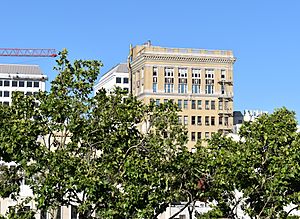
The CSA San Jose shares with San Francisco was the country's third-largest urban economy as of 2018, with a GDP of $1.03 trillion. Of the 500+ primary statistical areas in the U.S., this CSA had among the highest GDP per capita in 2018, at $106,757.
San Jose is a United States Foreign-Trade Zone. The city received its Foreign Trade Zone grant from the U.S. Federal Government in 1974, making it the 18th foreign-trade zone established in the United States. Under its grant, the City of San Jose is granted jurisdiction to oversee and administer foreign trade in Santa Clara County, Monterey County, San Benito County, Santa Cruz County, and in the southern parts of San Mateo County and Alameda County.
San Jose hosts many companies with more than 1,000 employees, including the headquarters of:
- Adobe
- Altera
- Brocade Communications Systems
- Cadence Design Systems
- Cisco Systems
- eBay
- Lee's Sandwiches
- Lumileds
- PayPal
- Roku, Inc.
- Rosendin Electric
- Sanmina-SCI
- Western Digital
- Xilinx
San Jose also hosts major facilities for Becton Dickinson, Ericsson, Hewlett Packard Enterprise, Hitachi, IBM, Kaiser Permanente, KLA Tencor, Lockheed Martin, Nippon Sheet Glass, and Qualcomm. The North American headquarters of Samsung Semiconductor are located in San Jose. Approximately 2000 employees will work at the new Samsung campus which opened in 2015.
Other large companies based in San Jose include:
- Align Technology
- Atmel
- Bloom Energy
- CEVA
- Cypress Semiconductor
- Cohesity, Echelon
- Extreme Networks
- GlobalLogic
- Harmonic
- Integrated Device Technology
- Maxim Integrated
- Micrel
- Move
- Netgear
- Novellus Systems
- Nutanix
- Oclaro
- OCZ
- Quantum
- SunPower
- Sharks Sports and Entertainment
- Supermicro
- Tessera Technologies
- TiVo
- Ultratech
- VeriFone
- Viavi Solutions
- Zoom Video Communications
- Zscaler
Sizable government employers include the city government, Santa Clara County, and San Jose State University. Acer's United States division has its offices in San Jose. Prior to its closing, Netcom had its headquarters in San Jose.
On July 31, 2015, Cupertino-based Apple Inc. purchased a 40-acre site in San Jose. The site, which is bare land, will be the site of an office and research campus where it is estimated that up to 16,000 employees will be located. Apple paid $138.2 million for the site. The seller, Connecticut-based Five Mile Capital Partners, paid $40 million for the site in 2010.
Wealth
San Jose is situated in the most affluent county in California and one of the most affluent counties in the United States.
With a median home price of $1,085,000 and the highest percentage of million-dollar (or more) homes in the United States, San Jose has the most expensive housing market in the United States and the fifth most expensive housing market in the world.
The cost of living in San Jose and the surrounding areas is among the highest in California and the nation, according to 2004 data. Housing costs are the primary reason for the high cost of living, although the costs in all areas tracked by the ACCRA Cost of Living Index are above the national average. Households in the city limits have the highest disposable income of any city in the U.S. with over 500,000 residents.
Silicon Valley
The large concentration of high-technology engineering, computer, and microprocessor companies around San Jose has led the area to be known as Silicon Valley. Area schools such as the University of California, Berkeley, University of California, Santa Cruz, San Jose State University, San Francisco State University, California State University, East Bay, Santa Clara University, and Stanford University pump thousands of engineering and computer science graduates into the local economy every year.
San Jose residents produce more U.S. patents than any other city. On October 15, 2015, the United States Patent and Trademark Office opened a satellite office in San Jose to serve Silicon Valley and the Western United States. By April 2018, Google was in the process of planning the "biggest tech campus in Silicon Valley" in San Jose. However, in April 2023, it was reported that Google paused on Google West San Jose Campus constructions due to slowing economic conditions and a decreased requirement for physical office space by tech companies, although the tech ecosystem has also recently become more geographically dispersed.
High economic growth during the tech bubble of the late 1990s led to elevated employment, housing prices, and traffic congestion. As the economy slowed in the early 2000s, employment and traffic congestion was somewhat diminished. In the mid-2000s, traffic along major highways again began to worsen as the economy improved. San Jose had 405,000 jobs within its city limits in 2006, and an unemployment rate of 4.6%. San Jose has the highest median income of any U.S. city with over 280,000 people.
On March 14, 2013, San Jose implemented a public wireless connection in its downtown area. Wireless access points have been placed on outdoor light posts throughout the city.
Media
San Jose is served by Greater Bay Area media. Print media outlets in San Jose include The Mercury News, the weekly Metro Silicon Valley, El Observador and the Silicon Valley / San Jose Business Journal. The Bay Area's NBC O&O, KNTV 11, is licensed to San Jose. In total, broadcasters in the Bay Area include 34 television stations, 25 AM radio stations, and 55 FM radio stations.
In April 1909, Charles David Herrold, an electronics instructor in San Jose, constructed a radio station to broadcast the human voice. The station, "San Jose Calling" (call letters FN, later FQW), was the world's first radio station with scheduled programming targeted at a general audience. The station became the first to broadcast music in 1910. Herrold's wife Sybil became the first female "disk jockey" in 1912. The station changed hands a number of times before becoming today's KCBS in San Francisco.
Top employers
As of June 30, 2024, the top employers in the city were:
| No. | San Jose's top employers | Employees |
|---|---|---|
| 1 | County of Santa Clara | 22,732 |
| 2 | City of San Jose | 8,262 |
| 3 | Cisco Systems | 7,500 |
| 4 | Adobe Systems, Inc. | 4,100 |
| 5 | San Jose State University | 4,086 |
| 6 | Kaiser Permanente | 3,969 |
| 7 | San Jose Unified School District | 3,609 |
| 8 | eBay | 3,088 |
| 9 | PayPal | 2,808 |
| 10 | Broadcom | 2,736 |
| 11 | Tik Tok | 2,601 |
| 12 | Target Stores | 2,437 |
| 13 | Super Micro Computer, Inc. | 2,422 |
| 14 | IBM | 2,300 |
| 15 | Western Digital | 2,159 |
Culture
Architecture
Because the downtown area is in the flight path to nearby Mineta San Jose International Airport (also evidenced in the above panoramic), there is a height limit for buildings in the downtown area, which is underneath the final approach corridor to the airport. The height limit is dictated by local ordinances, driven by the distance from the runway and a slope defined by Federal Aviation Administration regulations. Core downtown buildings are limited to approximately 300 ft (91 m) but can get taller farther from the airport.
There has been broad criticism over the past few decades of the city's architecture. Citizens have complained that San Jose is lacking in aesthetically pleasing architectural styles. Blame for this lack of architectural "beauty" can be assigned to the re-development of the downtown area from the 1950s onward, in which whole blocks of historic commercial and residential structures were demolished. Exceptions to this include the Downtown Historic District, the Hotel De Anza, and the Hotel Sainte Claire, both of which are listed in the National Register of Historic Places for their architectural and historical significance.
Municipal building projects have experimented more with architectural styles than have most private enterprises. The Children's Discovery Museum, Tech Museum of Innovation, and the San Jose Repertory Theater building have experimented with bold colors and unusual exteriors. The new City Hall, designed by Richard Meier & Partners, opened in 2005 and is a notable addition to the growing collection of municipal building projects.
San Jose has many examples of houses with fine architecture. Late 19th century and early 20th century styles exist in neighborhoods such as Hanchett Park, Naglee Park, Rose Garden, and Willow Glen (including Palm Haven).
Styles include Mediterranean Revival architecture, Spanish Colonial architecture, Neoclassical architecture, Craftsman, Mission Revival, Prairie style, and Queen Anne style Victorian.
Notable architects include Frank Delos Wolfe, Theodore Lenzen, Charles McKenzie, and Julia Morgan.
Visual arts
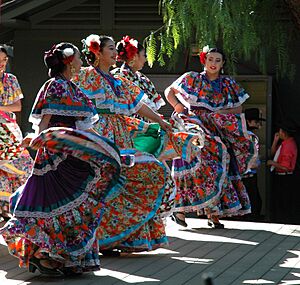
Public art is an evolving attraction in the city. The city was one of the first to adopt a public art ordinance at 2% of capital improvement building project budgets, and as a result of this commitment, a considerable number of public art projects exist in the downtown area, and a growing collection in neighborhoods including libraries, parks, and fire stations. In particular, the Mineta Airport expansion incorporated art and technology into its development.
Early public art included a statue of Quetzalcoatl (the plumed serpent) downtown, controversial in its planning because some called it pagan, and controversial in its implementation because many felt that the final statue by Robert Graham did not look like a winged serpent, and was more noted for its expense than its aesthetics.
A statue of Thomas Fallon also met strong resistance from those who called him largely responsible for the decimation of early native populations. Chicano/Latino activists protested because he had captured San Jose by military force in the Mexican–American War (1846). They also protested the perceived "repression" of historic documents detailing Fallon's orders expelling many of the city's Californio (early Spanish/Mexican/Mestizo) residents. In October 1991 protests at Columbus Day and Dia de la Raza celebrations stalled than plan, and the statue was stored in a warehouse in Oakland for more than a decade. The statue returned in 2002 to a less conspicuous location: Pellier Park, a small triangular patch at the merge of West Julian and West St. James streets.
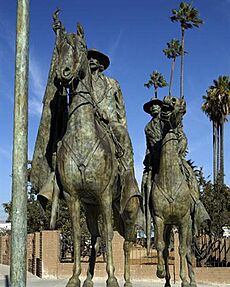
In 2001, the city-sponsored SharkByte, an exhibit of decorated sharks based on the mascot of the hockey team, the San Jose Sharks, and modeled after Chicago's display of decorated cows. Large models of sharks decorated in clever, colorful, or creative ways by local artists were displayed for months at dozens of locations around the city. After the exhibition, the sharks were auctioned off for charity.
In 2006, Adobe Systems commissioned an art installation titled San Jose Semaphore by Ben Rubin, at the top of its headquarters building. Semaphore is composed of four LED discs which "rotate" to transmit a message. The content remained a mystery until it was deciphered in August 2007. The visual art installation is supplemented with an audio track, transmitted from the building on a low-power AM station. The audio track provides clues to decode the message being transmitted.
San Jose retains a number of murals in the Chicano history tradition of Diego Rivera and José Clemente Orozco of murals as public textbooks.
Although intended to be permanent monuments to the city's heritage as a mission town founded in 1777, a number of murals have been painted over, notably Mural de la Raza, on the side of a Story Rd shoe store, and Mexicatlan at the corner of Sunset and Alum Rock. In addition, two of three murals by Mexican artist Gustavo Bernal Navarro have disappeared. The third mural, La Medicina y la Comunidad at the Gardner clinic on East Virginia Street, depicts both modern and traditional healers.
Surviving Chicano history murals include Nuestra Senora de Guadelupe at Our Lady of Guadalupe church and the 1970s or 1980s Virgen de Guadelupe Huelga Bird at Cal Foods east of downtown. The Guadalajara restaurant has the 1986 Guadalajara Market No. 2 by Edward Earl Tarver III and a 2013 work by Jesus Rodriguez and Empire 7, La Gran Culture Resonance.
An unknown artist painted the Huelga Bird and Aztec City mural in the 1970s or 1980s on the Clyde L. Fisher Middle School. In 1995 Antonio Nava Torres painted The Aztec Calendar Handball Court at Biebrach Park, and the unknown artist of Chaco's Pachuco painted it on the former Chaco's Restaurant in the 1990s. The Jerry Hernandez mural by Frank Torres at Pop's Mini Mart on King Road dates to 2009, and another recent mural by Carlos Rodriguez on the Sidhu Market at Locust and West Virginia depicts a stern-looking warrior.
Performing arts
The city is home to many performing arts companies, including Opera San Jose, Symphony Silicon Valley, Ballet San Jose Silicon Valley, sjDANCEco, The San Jose Symphonic Choir, Children's Musical Theater San Jose, the San Jose Youth Symphony, the San Jose Repertory Theatre, City Lights Theatre Company, The Tabard Theatre Company, San Jose Stage Company, and the now-defunct American Musical Theatre of San Jose which was replaced by Broadway San Jose in partnership with Team San Jose. San Jose is also home to the San Jose Museum of Art, one of the nation's premiere Modern Art museums.
The SAP Center at San Jose is one of the most active venues for events in the world. According to Billboard Magazine and Pollstar, the arena sold the most tickets to non-sporting events of any venue in the United States, and third in the world after the Manchester Evening News Arena in Manchester, England, and the Bell Centre in Montreal, Canada, for the period from January 1 – September 30, 2004.
The annual Cinequest Film Festival in downtown has grown to over 60,000 attendees per year, becoming an important festival for independent films. The San Francisco Asian American Film Festival is an annual event, which is hosted in San Francisco, Berkeley, and Downtown San Jose. Approximately 30 to 40 films are screened in San Jose each year at the Camera 12 Downtown Cinemas. The San Jose Jazz Festival is another of many events hosted throughout the year.
The Ira F. Brilliant Center for Beethoven Studies houses the largest collection of Ludwig van Beethoven in the world, outside of Europe, and is the only institution of its kind in North America.
Sports

| Club | Sport | Founded | League | Venue (capacity) |
|---|---|---|---|---|
| San Jose Sharks | Hockey | 1991 | National Hockey League | SAP Center (17,562) |
| San Jose Earthquakes | Soccer | 1995 | Major League Soccer | PayPal Park (18,000) |
| San Jose Barracuda | Hockey | 2015 | American Hockey League | Tech CU Arena (4,200) |
| San Jose Giants | Baseball | 1988 | California League | Excite Ballpark (4,200) |
| San Jose State Spartans | NCAA Football | 1893 | Mountain West Conference | CEFCU Stadium (21,520) |
San Jose is home to the San Jose Sharks of the NHL, the San Jose Barracuda of the AHL, and the San Jose Earthquakes of Major League Soccer. The Sharks and the Barracuda play in the SAP Center at San Jose. The Earthquakes built an 18,000 seat new stadium that opened in March 2015. San Jose was a founding member of both the California League and Pacific Coast League in minor league baseball. San Jose currently fields the San Jose Giants, a Low-A affiliate of the San Francisco Giants.
San Jose has been host to several U.S. Olympic team trials over the years. In 2004, the San Jose Sports Authority held the trials for judo, taekwondo, trampolining and rhythmic gymnastics at the San Jose State Event Center. SAP Center hosted the Gymnastic trials in 2012 and 2016 (women's only). and the U.S. Figure Skating Championships (used in Olympic years to select the Olympians) in 1996, 2012, and 2018. It was due to host the 2021 Championship, but that was moved to Las Vegas and it will instead host 2023. In 2008, around 90 percent of the members of the United States Olympic team were processed at San Jose State University prior to traveling to the 2008 Summer Olympics in Beijing. The 2009 Junior Olympics for trampoline were also held here.
In August 2004, the San Jose Seahawk Rugby Football Club hosted the USA All-Star Rugby Sevens Championships at Watson Bowl, east of Downtown. San Jose State hosted the 2011 American Collegiate Hockey Association (ACHA) national tournament. The NCAA Division I men's basketball tournament is also frequently held in San Jose.
From 2005 to 2007, the San Jose Grand Prix, an annual street circuit race in the Champ Car World Series, was held in the downtown area. Other races included the Trans-Am Series, the Toyota Atlantic Championship, the United States Touring Car Championship, the Historic Stock Car Racing Series, and the Formula D Drift racing competition.
In the 2010s, San Jose "aggressively wooed" the Oakland Athletics to relocate to San Jose from nearby Oakland, but the San Francisco Giants exercised a veto against this proposal. In 2013, the city of San Jose sued Major League Baseball for not allowing the Athletics to relocate to San Jose. On October 5, 2015, the United States Supreme Court rejected San Jose's bid on the Athletics, who in 2023 announced they would relocate to Las Vegas.
Landmarks
Notable landmarks in San Jose include Children's Discovery Museum of San Jose, History Park at Kelley Park, Cathedral Basilica of St. Joseph, Plaza de César Chávez, Dr. Martin Luther King, Jr. Library, Mexican Heritage Plaza, Rosicrucian Egyptian Museum, Lick Observatory, Hayes Mansion, SAP Center at San Jose, Hotel De Anza, San Jose Improv, Sikh Gurdwara of San Jose, Peralta Adobe, Excite Ballpark, Spartan Stadium, Japantown San Jose, Winchester Mystery House, Raging Waters, Circle of Palms Plaza, San Jose City Hall, San Jose Flea Market, Oak Hill Memorial Park, San Jose electric light tower, and The Tech Museum of Innovation.
-
The historic Sainte Claire Hotel, today The Westin San Jose
Museums and institutions
- The Tech Museum of Innovation
- Ira F. Brilliant Center for Beethoven Studies, which houses the largest collection of Ludwig van Beethoven in the world outside of Europe
- Dr. Martin Luther King, Jr. Library, the largest U.S. public library west of the Mississippi River
- San Jose Museum of Art, contemporary art museum with a collection of West Coast artists
- Children's Discovery Museum of San Jose
- History Park at Kelley Park
- Mexican Heritage Plaza, a Chicano museum and cultural center
- Movimiento de Arte y Cultura Latino Americana, an inclusive contemporary arts museum grounded in the Chicano/Latino experience
- Portuguese Historical Museum
- Rosicrucian Egyptian Museum, the largest collection of Egyptian artifacts on display in the western United States, located at Rosicrucian Park
- San Jose East Carnegie Branch Library is notable as it is the last Carnegie library still operating in San Jose, and is on the National Register of Historic Places.
- San Jose Steam Railroad Museum, proposed, artifacts and rolling stock are kept at the fairgrounds and Kelley Park
- History San José
- Japanese American Museum of San Jose, a museum of Japanese-American history
- Old Bank of America Building, a historic landmark
- San Jose Museum of Quilts & Textiles, the first museum in America dedicated solely to quilts and textiles as an art form
- Viet Museum, a museum of Vietnamese-American history
Education
Higher education
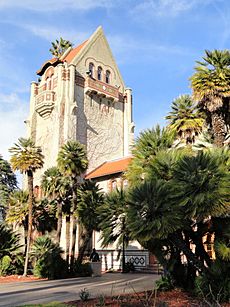
San Jose is home to several colleges and universities. The largest is San José State University, which was founded by the California legislature in 1862 as the California State Normal School, and is the founding campus of the California State University (CSU) system. Located in downtown San Jose since 1870, the university enrolls approximately 35,000 students in over 250 different bachelor's, master's and doctoral degree programs.
The school enjoys a good academic reputation, especially in the fields of engineering, business, computer science, art and design, and journalism. San Jose State is one of only three Bay Area schools that fields a Football Bowl Subdivision (FBS) Division I college football team; Stanford University and U.C. Berkeley are the other two.
California University of Management and Technology (CALMAT) offers many degree programs, including MBA, Computer Science, Information Technology. Most classes are offered both online and in the downtown campus. Many of the students are working professionals in the Silicon Valley.
The University of Silicon Valley is located in the Golden Triangle of North San Jose.
Lincoln Law School of San Jose and University of Silicon Valley Law School offer law degrees, catering to working professionals.
National University maintains a campus in San Jose.
The San Jose campus of Golden Gate University offers business bachelor and MBA degrees.
In the San Jose metropolitan area, Stanford University is in Stanford, California, Santa Clara University is in Santa Clara, California, and U.C. Santa Cruz is in Santa Cruz, California. Within the San Francisco Bay Area, other universities include U.C. Berkeley, U.C. San Francisco, U.C. Hastings College of Law, University of San Francisco, and California State University, East Bay.
The San Jose area's community colleges, San Jose City College, West Valley College, Mission College and Evergreen Valley College, offer associate degrees, general education units to transfer to CSU and UC schools, and adult and continuing education programs. The West campus of Palmer College of Chiropractic is also located in San Jose.
WestMed College is headquartered in San Jose and offers paramedic training, emergency medical technician training, and licensed vocational nursing programs.
The University of California operates Lick Observatory atop Mount Hamilton.
Western Seminary has one of its four campuses in San Jose, which opened on the campus of Calvary Church of Los Gatos in 1985. The campus relocated in 2010 to Santa Clara. Western is an evangelical, Christian graduate school that provides theological training for students who hope to serve in a variety of ministry roles including pastors, marriage and family therapists, educators, missionaries and lay leadership. The San Jose campus offers four master's degrees, and a variety of other graduate-level programs.
National Hispanic University offered associate and bachelor's degrees and teaching credentials to its students, focusing on Hispanic students, until its closing in 2015.
Primary and secondary education
Until the opening of Lincoln High School in 1943, San Jose students only attended San Jose High School. San Jose has 127 elementary, 47 middle, and 44 public high schools.
Public education in the city is provided by four high school districts, fourteen elementary districts, and three unified school districts (which provide both elementary and high schools).
- Unified school districts include: San Jose USD (SJUSD), Morgan Hill USD, and Santa Clara USD
- Secondary school districts include: Campbell UHSD, East Side UHSD, Fremont UHSD, and Los Gatos-Saratoga JUSD
- Elementary school districts include: Alum Rock UESD, Berryessa UESD, Cambrian ESD, Campbell UESD, Cupertino UESD, Evergreen ESD, Franklin-McKinley ESD, Los Gatos UESD, Luther Burbank ESD, Moreland SD, Mount Pleasant ESD, Oak Grove ESD, Orchard ESD, and Union ESD.
SJUSD declared bankruptcy in 1983; at that time, it was the largest US school district to declare bankruptcy. Observers identified the reasons as a drop of 5,000 students in the preceding years, the difficulties imposed on school finances by Serrano v. Priest in 1968, the reduction of tax monies because of 1978 California Proposition 13, and the local teachers' union contract requiring a raise in pay.
Private schools in San Jose are primarily run by religious groups. The Catholic Diocese of San Jose has the second-largest student population in Santa Clara County, behind only SJUSD; the diocese and its parishes operate several schools in the city, including five high schools. Other private religious schools are Baptist, non-denominational Protestant, and Wisconsin Synod Lutheran. Secular private schools include Cambrian Academy and Harker School.
Libraries
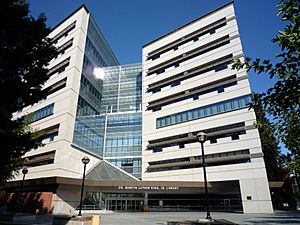
The San José Public Library system is unique in that the Dr. Martin Luther King Jr. Library combines the collections of the city's system with the San Jose State University main library. In 2003, construction of the library, which now holds more than 1.6 million items, was the largest single library construction project west of the Mississippi, with eight floors that result in more than 475,000 sq ft (44,100 m2) of space with a capacity for 2 million volumes.
The city has 23 neighborhood branches including the Biblioteca Latinoamericana ('Latin American Library') which specializes in Spanish language works. The East San Jose Carnegie Branch Library, a Carnegie library opened in 1908, is the last Carnegie library in Santa Clara County still operating as a public library and is listed in the National Register of Historic Places. As the result of a bond measure passed in November 2000, a number of brand new or completely reconstructed branches have been completed and opened. The yet-to-be-named brand new Southeast Branch is also planned, bringing the bond library project to its completion.
The San Jose system (along with the university system) were jointly named as "Library of the Year" by Library Journal in 2004.
Transportation
Like other American cities built mostly after World War II, San Jose is highly automobile-dependent, with 76 percent of residents driving alone to work and 12 percent carpooling in 2017. The city set an ambitious goal to shift motorized trips to walking, bicycling, and public transit in 2009 with the adoption of its Envision San Jose 2040 General Plan. In 2018, the city extended these goals to 2050 with its San Jose Climate Smart plan.
Public transit
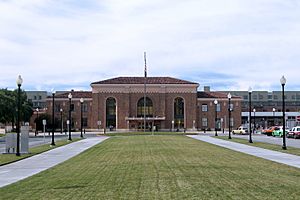
Rail service to and from San Jose is provided by Amtrak (the Sacramento–San-Jose Capitol Corridor and the Seattle–Los-Angeles Coast Starlight), Caltrain (commuter rail service between San Francisco and Gilroy), ACE (commuter rail service to Pleasanton and Stockton), and the local VTA light rail system connecting downtown to Mountain View, Milpitas, Campbell, and Almaden Valley, operated by the Santa Clara Valley Transportation Authority (VTA). Historic streetcars from History Park operate on the light rail lines in downtown during holidays.
Long-term plans call for BART to be expanded to Santa Clara from the Berryessa/North San José station. Originally, the extension was to be built all at once, but due to the recession, sales tax revenue has dramatically decreased. Because of this, the extension will be built in two phases. Phase 1 extended service to San Jose with the completion of the Milpitas and Berryessa BART stations on June 13, 2020. In addition, San Jose will be a major stop on the future California High-Speed Rail route between Los Angeles and San Francisco. Diridon Station (formerly Cahill Depot, 65 Cahill Street) is the meeting point of all regional commuter rail service in the area. It was built in 1935 by the Southern Pacific Railroad, and was refurbished in 1994.
VTA also operates many bus routes in San Jose and the surrounding communities, as well as offering paratransit services to local residents. Additionally, the Highway 17 Express bus line connects central San Jose with Santa Cruz. Intercity bus providers include Greyhound, BoltBus, Megabus, California Shuttle Bus, TUFESA, Intercalifornias, Hoang, and USAsia. FlixBus also services the city with a stop at 129 W San Carlos.
Air
San Jose is served by Norman Y. Mineta San Jose International Airport 2 mi (3.2 km) northwest of downtown, and by Reid-Hillview Airport of Santa Clara County, general aviation airport located in the eastern part of San Jose. San Jose residents also use San Francisco International Airport, a major international hub located 35 mi (56 km) to the northwest, and Oakland International Airport, another major international airport located 35 mi (56 km) to the north. The airport is also near the intersections of three major freeways, US 101, I-880, and SR 87.
Highways
The San Jose area is served by a freeway system that includes three Interstate freeways and one U.S. Route. It is, however, the largest city in the country not served by a primary (one- or two-digit route number) Interstate; most of the Interstate Highway Network was planned by the early 1950s well before San Jose's rapid growth decades later.
US 101 runs south to the California Central Coast and Los Angeles, and then runs north up near the eastern shore of the San Francisco Peninsula to San Francisco. I-280 also heads to San Francisco, but goes along just to the west of the cities of the San Francisco Peninsula. I-880 heads north to Oakland, running parallel to the southeastern shore of San Francisco Bay. I-680 parallels I-880 to Fremont, but then cuts northeast to the eastern cities of the San Francisco Bay Area.
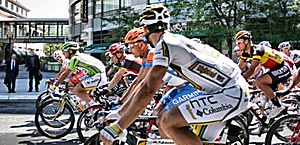
Several state highways also serve San Jose: SR 17, SR 85, SR 87 and SR 237. Additionally, San Jose is served by a system of county-wide expressways, which includes the Almaden Expressway, Capitol Expressway, San Tomas Expressway, and Lawrence Expressway.
Several regional transportation projects have been undertaken in recent years to manage congestion on San Jose freeways. This includes expanding State Route 87 to add more lanes near the downtown San Jose area.
The interchange for I-280 connecting with I-680 and U.S. 101 was named the Joe Colla Interchange.
Major highways:
Bicycling
Central San Jose has seen a gradual expansion of bike lanes over the past decade, which now comprise a network of car-traffic-separated and buffered bike lanes. San Jose Bike Party is a volunteer-run monthly social cycling event that attracts up to 1,000 participants during summer months to "build community through bicycling". Fewer than one percent of city residents ride bicycles to work as their primary mode of transportation, a statistic unchanged in the past ten years. Typically, between three and five residents are struck and killed by car drivers while bicycling on San Jose streets each year.
Notable people
Sister cities
San Jose has one of the oldest Sister City programs in the nation. In 1957, when the city established a relationship with Okayama, Japan, it was only the third Sister City relationship in the nation, which had begun the prior year. The Office of Economic Development coordinates the San Jose Sister City Program which is part of Sister Cities International. As of 2014[update], there are eight sister cities:
- Okayama, Japan (established on May 26, 1957)
- San José, Costa Rica (1961)
- Veracruz, Mexico (1975)
- Tainan, Taiwan (1977)
- Dublin, Ireland (1986)
- Yekaterinburg, Russia (1992)
- Pune, India (1992)
- Guadalajara, Mexico (2014)
See also
 In Spanish: San José (California) para niños
In Spanish: San José (California) para niños












